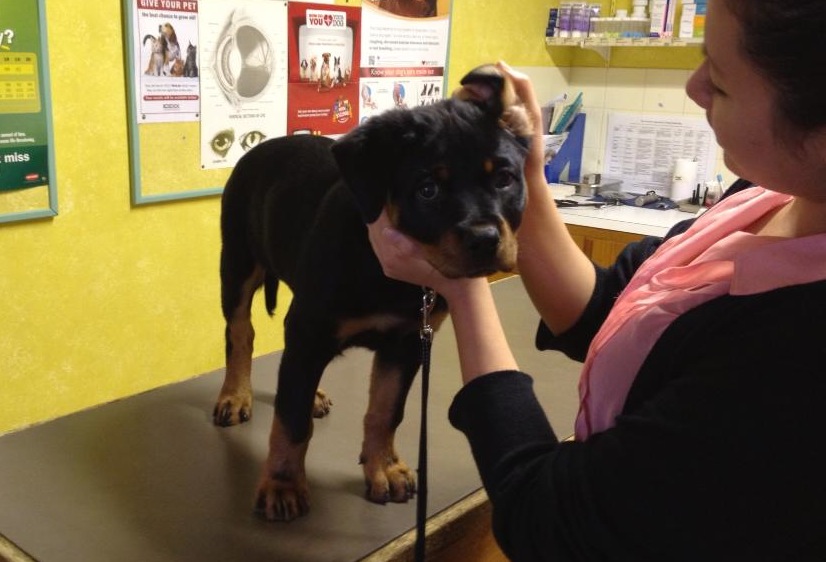Desexing: It’s bad for vizslas, too
Late last year, a study was published looking at the incidence of cancer in desexed golden retrievers, finding a correlation between earlier desexing (before one year old) and certain types of cancer.
Now, in February, there is a new study supporting many of the findings in the golden retriever study, but this time looking at the incidence of cancers in Hungarian Vizslas. As behavioural disorders are also common in the breed, the researchers decided to look at the impact of desexing on these disorders, as well.
While we will look at their findings in more detail, the main take home points from this research are (quote):
“revealed that gonadectomized dogs had significantly higher odds than did sexually intact dogs of having mast cell tumour, hemangiosarcoma, lymphoma or lymphosarcoma, all other cancers, all types of cancer combined or behavioral disorders, regardless of the age at which the dog was gonadectomzied. The 2 exceptions were that male dogs gonadectomized at [less than or equal to] 12 months of age did not have a higher risk of developing hemangiosarcoma and dogs gonadectomized at > 6 months of age did not have a higher risk of developing a behavioural disorder, other than fear of storms.”
And it is important to note that the age of onset was earlier for all cancers and disorders when the dog was desexed.
So now that has wet your appetite, we will look at the research in more detail.
About the Study
This was a retrospective cohort study – meaning it was a piece of research based on events that had happened over time, looking back at that time.
The study included 2,505 vizslas born between 1992 and 2008. Of them:
- 604 of the vizslas had cancer(s),
- 648 had behavioural disorders,
- 1,421 of them were desexed,
- 362 vizslas were desexed at 6 months or earlier (209 of these were female, and 153 of these were male),
- 298 vizslas were desexed at 7-12 months (157 were female, 141 were male), and
- 711 vizslas were desexed at 12 months (459 females, 312 males).
Data for this study was collected from an online survey conducted during 2008, which targeted vizsla owners to partake by advertising through breed clubs, email lists, websites, magazines, and newsletters. 75% of respondents were involved with Vizsla breed clubs, so it was a biased sample.
Participants came from 25 countries in all, including the US, UK, Canada, and Australia.
This study was designed to consider age of desexing and its effects, so the owners were asked to identify when their dog was desexed, or if it was not at all. It’s important to note that many studies simply look at ‘entire’ or ‘desexed’ and don’t look at lifetime exposure to gonads – this is one of few in a new study of research actually considering the time of desexing.
Cancer
An earlier Vizsla Health Survey found that cancer, especially hemangiosarcoma and lymphoma, “was listed as the most common cause of death in the breed.” Desexing was associated with the development of these cancers, according to their survey, and also associated with the development of behavioural disorders.
This is no surprise, as numerous studies have linked desexed with various types of cancer, including hemangiosarcoma, but also prostate cancer, transitional cell carcinoma, and osteosarcoma.
This research show that a desexed vizsla was 5 times as likely to have cancer (other than mast cell cancer, hemangiosarcoma, or lymphoma or lymphosarcoma) than vizslas that were entire.
Not only were desexed dogs more likely to get cancer, but the earlier they were desexed, the earlier they were diagnosed with cancer.
All in all, dogs desexed at any age were more likely to have cancer than dogs not desexed.
Interestingly, though, “There was no significant difference in the longevity of gonadectomized Vizslas, compared with the longevity for those that remained sexually intact”. This means that even though desexed dogs were more likely to get cancer, and sooner, this didn’t seem to make them die younger.
Hemangiosarcoma
When it comes to hemangioarcoma, desexed females were 9 times as likely to get hemangiosarcoma than entire females.
For males, males neutered after 12 months of age had a higher risk of developing hemangiosarcoma.
The research makes note that this is not a ‘one off’ event: “Of concern, studies have found an increased risk of hemangiosarcoma, a common tumour that frequently leads to fatal outcomes, in gonadectomized dogs, which is in concurrence with findings for the present study.” That means that vizslas are not alone in being more likely to develop hemangiosarcoma when desexed, especially when it comes to bitches.
Mast Cell Cancer
Desexed vizslas got mast cell cancer at a significantly higher rate (3.5 times more likely) than entire dogs, and they got diagnosed with this cancer sooner than entire dogs.
Lymphosarcoma
While there was no difference between females and males in the likelihood of developing lymphoma or lymphosarcoma, desexed vizslas were significantly more likely (4.3 times as high incidence) entire.
Mammary Cancer
There is some evidence that bitches left entire for longer are more likely to develop mammary cancer. However, this study says, “authors of a recent systematic review of all reports in peer-reviewed journals on the associations among neutering, age at neutering, and mammary gland tumours concluded that the evidence that neutering reduces the risk of mammary gland neoplasia is weak and not a sound basis for firm recommendations on neutering because of limited evidence and bias in published results”. We can, at least, say there is some debate on the correlation of mammary cancers and desexing.
In regard to this study, mammary cancer was not common. There were 1,360 female dogs in the study, with 535 of them being entire, and only 11 developed mammary tumours. That is, 2% of entire bitches got breast cancer. (The authors of this study also note that 10 of those 11 bitches were desexed at later than 5 years old.)
This equates to only .4% of the dogs in the 2505 strong study developed mammary cancer. In comparison, 11% of the 2505 dogs in the study having mast cell cancer, hemosarcoma, lymphoma, or lymphosarcoma.Considering this, community emphasis on mammary cancer seems misguided as it is not biggest concern, especially in this breed.
Behavioural Disorders
There have been studies that have shown a correlation between gonadectomy and behavioural problems, but whether these affects on behaviour are ‘good’ or ‘bad’ is a matter of debate, with different studies showing different things.
The Vizsla Health Survey found that behavioural problems were prevalent in the breed, hence the focus of this study on behavioural problems. These types of behviour problems were mostly fear, anxiety, and increased arousal.
This study did something clever though: Dogs who had a behavioural problem before desexing were excluded from the analysis. The logic? “Excluding dogs that might have been gonadectomized because of a behavioural problem eliminated a confounding factor that could have incorrectly suggested a stronger association between gonadectomy and behavioural problems.”
Desexed vizslas were more likely to have behavioural problems than sexually intact dogs, and dogs desexed at or before 6 months had a 1.8 times higher incidence of behavioural disorders than sexually intact dogs. These behavioural problems included: fear of storms, separation anxiety, fear of noises, fear of gunfire, timidity, excitability, submissive urination, aggression, hyperactivity, and fear biting.
As with cancer, the younger the dog was at time of desexing, the earlier a behavioural problem was diagnosed.
Fear of storms was particularly significant. Desexed dogs were 4.1 times more likely to be scared of storms than entire dogs. Bitches were more likely to be scared of storms than males – but males desexed younger was more likely to be scared of storms earlier. (Desexing time didn’t change when females became fearful of storms.)
The author notes, “It should be mentioned that the most common behavioral problems in Vizslas in this study did not include sexual behaviours (eg, mounting and urine marking).”
Why is it so?
Briefly, this study predicted that sex steroids such as estrogen, progesterone, and testosterone is related to immunity, especially the surveillance for cancer cells. That is, without gonads to produce sex hormones, the immune system does not function as normal.
Highlights
To me, the most important points from this study are:
- There seems to be no compelling reason to desex Vizslas in regard to that individual dog’s health or temperament, on the basis of this study.
- Desexing does not inevitably result in a healthier and more temperamentally stable dog.
- As orthopaedic problems are not common in Vizslas, this study does not consider joint disorders and desexing, as other studies have.
- Despite the incidence of cancer in neutered dogs, this study suggests that desexed and intact Vizslas live about the same length of time.
- Vets need to discuss the pros and cons of desexing with clients.
Further Research Discussion
This kind of research is just the beginning! Further research can consider:
- Are Vizslas special? We need to do this type of research in other breeds.
- For all studies considering affects of desexing, age of desexing should be considered in the data collected. There are very few studies looking at life-long gonad exposure, and so conclusions on optimum age of desexing is hard to make.
- Biological effects of removing gonads.
- Sterilisation for dogs without gonadectomy – like vasectomies or hysterectomies (leaving ovaries).
- Something that I have been considering for a while,” An additional potential source of confounding was that behavioural differences between sexually intact and gonadectomized dogs could have been attributable to being subjected to hospitalisation and survey at a young age, rather than to the hormonal changes conferred by gonadectomy. A prospective, randomised blinded study with a control (sham) surgery could be performed to distinguish between these 2 scenarios.”
- More research on gonadectomies, on cancer, and on behaviour, and how they’re connected.
Reference:
Zink MC, Farhoody P, Elser SE, Ruffini LD, Gibbons TA, & Rieger RH (2014). Evaluation of the risk and age of onset of cancer and behavioral disorders in gonadectomized Vizslas. Journal of the American Veterinary Medical Association, 244 (3), 309-19 PMID: 24432963
Image Credit: Thanks to klam101 on DeviantArt.
Further Reading:
Why would you NOT desex your dog???
Golden Retrievers: Cancer if you do, cancer if you don’t
DON’T Spay or Neuter Your Pets
New Research That Raises Questions About Neutering Recommendations





